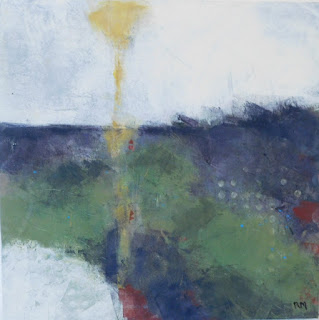Of Poetry and Place
 |
| I Have a Desire to Go |
 |
| A Brighter Dawn |
 |
| Block by Block |
 |
| Sanctuary |
 |
| Bay Side |
 |
| My Sun Is at Noon |
By Tom Wachunas
…The earth never
tires,
The earth is rude,
silent, incomprehensible at first, Nature is rude and incomprehensible at
first,
Be not discouraged,
keep on, there are divine things well envelop’d,
I swear to you there are
divine things more beautiful than words can tell….
- from Song of the
Open Road, by Walt Whitman
EXHIBIT: Earth Sky Sea - paintings and assemblages by
Robyn Martins / at Lynda Tuttle’s Art Center, 209 Sixth St. NW, downtown
Canton, Ohio, through June 29, 2019
/ GALLERY HOURS: Wed. and Thurs. 4 to 8
p.m., Saturday 10 a.m. to noon / 5 to 10
p.m. on First Fridays / Visits also by appointment, call 330-452-8211 to
schedule / artist website at:
An interesting
article in The Canton Repository by Dan Kane (May 23) piqued my curiosity about
North Canton artist Robyn Martins. I think it would be good for you to read it
and get some background before reading my take on her paintings. Here’s a link:
The conceptual thrust
of Martins’ particular style of abstraction springs from her being inspired by
poetry. She tells us in Kane’s article, “I’m informed by the nature of the
poem…Sometimes I scratch text right into the painting. It’s not always legible,
but I know it’s there.”
When ‘scratched’ texts are visible, such as in
Afoot and Lighthearted (poem from
Walt Whitman), or I Have a Desire to Go (poem
from Gerald Manley Hopkins), they’re integrated in an unobtrusive manner. Think
of them as singularly quiet thoughts, afloat in places still being formed from
the mists of memory, or yearning.
Those amorphous
mists are rendered in thin layers of oil paint blended with cold wax, giving
the paintings a matte finish and a subtly earthen texture. Martins’ palette is
subtle, too. Not mute, though. There are voices here, near and distant, often murmuring
or whispering in hushed tones, and sometimes rising in volume to relatively
more saturated hues.
With or without the
cueing function of words, Martins’ iconography doesn’t come off as meticulously
detailed representations of specific locales. Her images aren’t literal
illustrations so much as they’re distillations, conjurings, evocations.
Essences of places in the process of being retrieved, or newly discovered.
Poems in themselves, really.
These captivating
meditations merit considerably more actual wall space for viewing than what
they’ve been given. Paintings, and our eyes, need room to breathe, free from
too many surrounding objects competing for attention. As it is here, the life
in Martins’ paintings feels just a bit stifled. Her pieces have been crowded together
like so many stacked greeting cards on a retail rack. They deserve a much more
formal and elegant gallery setting – the kind which presently doesn’t exist in
the downtown Canton arts district.

No comments:
Post a Comment